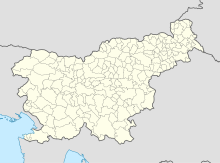Sterntal camp
Coordinates: 46 ° 23 ′ 39 ″ N , 15 ° 47 ′ 52 ″ E
The camp Sterntal (also Sternthal , Slovenian Taborišče Sterntal or Strnisce ) was an internment camp in what is now municipality Kidričevo in Ptuj , which during the Second World War as a labor camp in the construction of an aluminum factory and in 1945 as a central collection point for the expulsion of ethnic Germans from Slovenia served.
history
During the First World War , a prisoner of war camp was established on the site . It later served as a refugee camp for refugees from the coastal country , from where many civilians had to flee because of the Isonzo battles . There was also a military hospital on the site , where the wounded from the Isonzo front as well as prisoners of war and refugees from Primorska were cared for.
In 1942 the German occupation authorities set up a labor camp in which prisoners of war and forced laborers were interned for the construction of an alumina factory for aluminum production on the Ptuj - Pragersko railway line . A hydropower plant on the Drau was provided for the necessary electricity . In addition to prisoners, regular workers were also involved in the construction. The United Aluminum Works (VAW) began building the factory in 1942, but the work could not be completed by the end of the war. The aluminum factory (today Talum ) was not completed until 1947–1954. On March 15, 1944, the occupation authorities decreed that relatives of deserters would be obliged to do forced labor. The Sterntal camp, which took in many of those affected, was renamed the Sterntal Special Compulsory Penalty Camp.
In May 1945, the OZNA under the direction of Aleksandar Ranković set up a " concentration camp " (koncentracijsko taborišče) in the area of the former forced labor camp , to which ethnic Germans from all over Slovenia, especially from Lower Styria and Gottschee , were brought. In addition, Slovenes and members of the Hungarian minority from Prekmurje were also detained there.
Due to overcrowding and poor hygiene, diseases spread in the Sterntal camp, including dysentery and typhus . The prisoners were subjected to particular physical and mental tortures, and many were shot. Young children and the elderly were particularly high among the fatalities. In addition to " old age ", diarrhea and dysentery were given as causes of death. In total, between 800 and 1,000 and 4,000 people perished in the Sterntal camp, which was intended for 2,000 people but was permanently occupied by around 8,000-12,000 people, from May to October 1945 or up to 5,000 people in the entire period of its existence, but are still lying no more precise data.
Other camps in which ethnic Germans were imprisoned were in Hrastovec , Brestrnica , Studenci pri Mariboru and Teharje .
In October 1945, after the intervention of the Red Cross , the Sterntal camp was closed and most of the survivors - unless they were sent to other camps - were deported to Austria .
literature
- Michael Portmann (2002): Communist accounting with war criminals, collaborators, 'enemies of the people' and 'traitors' in Yugoslavia during the Second World War and immediately afterwards (1943–1950), GRIN-Verlag Vienna 2003. Chapter 6.8. The expulsion of the Germans from Slovenia (pp. 123–125). Diploma thesis University of Vienna 2002.
- Milko Mikola (2007): Dokumenti in pričevanja o povojnih koncentracijskih taboriščih v Sloveniji: koncentracijska taborišča Strnišče, Hrastovec, Brestrnica in Filovci. Ljubljana, Ministrstvo za pravosodje Republike Slovenije, 2007
Individual evidence
- ↑ Presentation of the history of the camp by today's municipality of Kidričevo (in Slovenian, without mentioning the role of the camp in the expulsion of the Germans; inmates of the UDBA camp after the war were "political prisoners, helpers of the occupiers and prisoners of war") ( Memento from August 14, 2011 in the Internet Archive )
- ↑ Damjan Hančič; Renato Podberšič: Totalitarian regimes in Slovenia in the 20th century. In: Slovenian Presidency of the Council of the European Union, Peter Jambrek (Ed.): Crimes committed by totalitarian regimes (PDF file; 4.4 MB). Pp. 39–60, here p. 47.
- ↑ Michael Portmann (2002), p. 124.
- ↑ see "Koncentracijsko taborišče Strnišče pri Ptuju, OZNA, August 5, 1945" with a list of 7 camp inmates who are to be buried ...
- ↑ a b c Milko Mikola: Concentration and labor camps in Slovenia. In: Slovenian Presidency of the Council of the European Union, Peter Jambrek (Ed.): Crimes committed by totalitarian regimes (PDF file; 4.4 MB). Pp. 145–154, here p. 147.
- ↑ Ernst Hochberger u. a .: The Germans between Carpathians and Carniola, p. 132. Study series of the East German Cultural Council Foundation, Volume 4. Langen Müller, Munich 1994
- ↑ Darja Lukman Žunec: Povojno taborišče Strnišče, Večer, May 6, 1996, podlistek (feuilleton)
- ↑ VLÖ: Crimes against the old Austrian German ethnic groups ( page no longer available , search in web archives ) Info: The link was automatically marked as defective. Please check the link according to the instructions and then remove this notice.
- ^ Rajko Topolovec (Ptuj): Živečim svojcem in drugim narodom bi se morali iskreno opravičiti, Večer January 18, 2008
- ↑ Hans Krainer: The Partisans in Krain, the end of Krainer Germanness, 1941-1945

